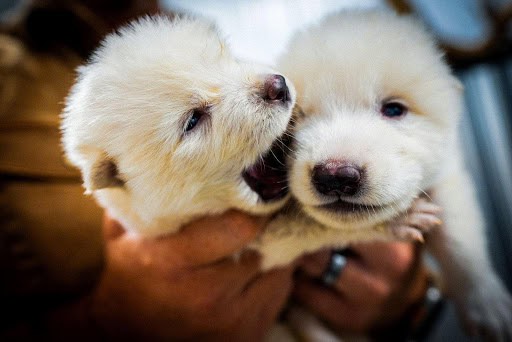In a watershed moment for conservation science, Dallas-based biotech company Colossal Biosciences has announced the successful birth of three dire wolves (Aenocyon dirus) — the first-ever de-extinct animals created through advanced genetic engineering. This achievement, revealed on April 8, 2025, represents the resurrection of an apex predator that vanished from North America approximately 12,000 years ago.
From Ancient DNA to Living Reality
The three healthy dire wolf pups include two males born in October 2024, named Romulus and Remus, and a female named Khaleesi born in January 2025. According to Colossal, these animals are not merely conceptual approximations but genuine dire wolves, carrying genetic traits absent from Earth for over ten millennia.
“Our team took DNA from a 13,000-year-old tooth and a 72,000-year-old skull and made healthy dire wolf puppies,” said Ben Lamm, CEO of Colossal. “It was once said, ‘any sufficiently advanced technology is indistinguishable from magic.’ Today, our team gets to unveil some of the magic they are working on and its broader impact on conservation.”
The achievement required breakthrough advances in ancient DNA extraction, gene editing, and reproductive technology. Colossal’s scientists sequenced DNA from dire wolf fossils, identified key genetic variants, and precisely edited 20 sites across 14 genes in cells from modern gray wolves — the dire wolf’s closest living relative. These modified cells were then used in a somatic cell nuclear transfer process (cloning) to create viable embryos that were implanted into surrogate mothers.
Notable Dire Wolf Traits Emerge
At approximately six months old, the male pups already weigh around 80 pounds and display distinctly dire wolf characteristics — thick white fur, broad heads, and hefty builds. Their behavior also reveals their wild nature; unlike domestic puppies, they maintain distance from humans and exhibit caution even toward familiar caretakers.
“These are not dogs, or even modern-day wolves. They’re dire wolf pups, back from extinction after some 12,000 years,” notes Colossal in their announcement materials.
The pups reside in a secure 2,000+ acre preserve certified by the American Humane Society, where they receive round-the-clock monitoring and care. The facility includes naturalistic habitats designed to accommodate the animals’ specific needs.
Scientific Leadership Behind the Breakthrough
Harvard geneticist and Colossal co-founder Dr. George Church highlighted the scientific significance: “The dire wolf is an early example of this [de-extinction technology], including the largest number of precise genomic edits in a healthy vertebrate so far — a capability that is growing exponentially.”
Dr. Beth Shapiro, Colossal’s Chief Science Officer and a leading expert in ancient DNA, spearheaded the genomic reconstruction that made the achievement possible. “Our novel approach to iteratively improve our ancient genome in the absence of a perfect reference sets a new standard for paleogenome reconstruction,” Shapiro explained. Her team’s analysis revealed new insights about dire wolf evolution, including the discovery that the species emerged through hybridization of two ancient canid lineages between 3.5 and 2.5 million years ago.
Conservation Applications Already Evident
Beyond the headline-grabbing resurrection of an extinct species, Colossal simultaneously announced a significant conservation achievement: the birth of four cloned red wolves, among the most endangered canids on the planet. These wolves were produced using the same innovative “non-invasive blood cloning” technique developed for the dire wolf work.
“The same technologies that created the dire wolf can directly help save a variety of other endangered animals,” noted Dr. Christopher Mason, a scientific advisor for Colossal. “This is an extraordinary technological leap for both science and conservation.”
With fewer than 20 red wolves remaining in the wild, this application demonstrates how de-extinction technology can help preserve genetic diversity in critically endangered species. The cloned red wolves could increase the founding lineages in captive breeding programs by 25%, potentially revitalizing recovery efforts.
Cultural Resonance
Beyond its scientific importance, the dire wolf’s return has captured public imagination, particularly given the species’ prominence in popular culture through works like “Game of Thrones.” George R.R. Martin, the author who popularized dire wolves in his fantasy series and a Colossal investor, remarked: “I get the luxury to write about magic, but Ben and Colossal have created magic by bringing these majestic beasts back to our world.”
The achievement has also resonated with indigenous communities. Mark Fox, Tribal Chairman of the MHA Nation, observed that “The de-extinction of the dire wolf is more than a biological revival. Its birth symbolizes a reawakening — a return of an ancient spirit to the world.”
As Colossal continues developing its de-extinction platform, the company has indicated plans to apply similar methods to its other headline goals, including reintroducing the woolly mammoth by 2028 and reviving the thylacine (Tasmanian tiger) and dodo thereafter.
This milestone in genetic engineering and conservation biology represents both the fulfillment of a long-held scientific aspiration and the beginning of a new chapter in humanity’s relationship with extinction itself.



